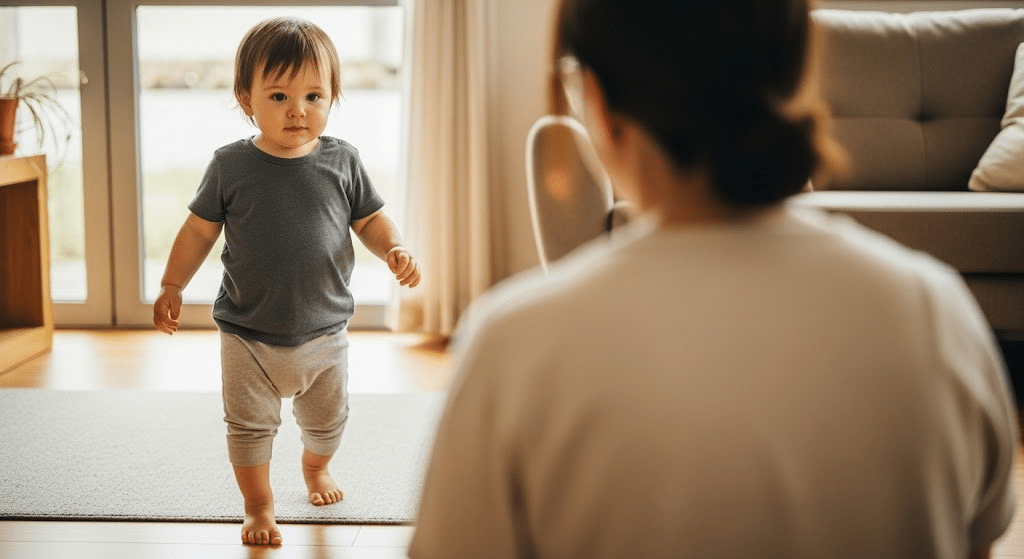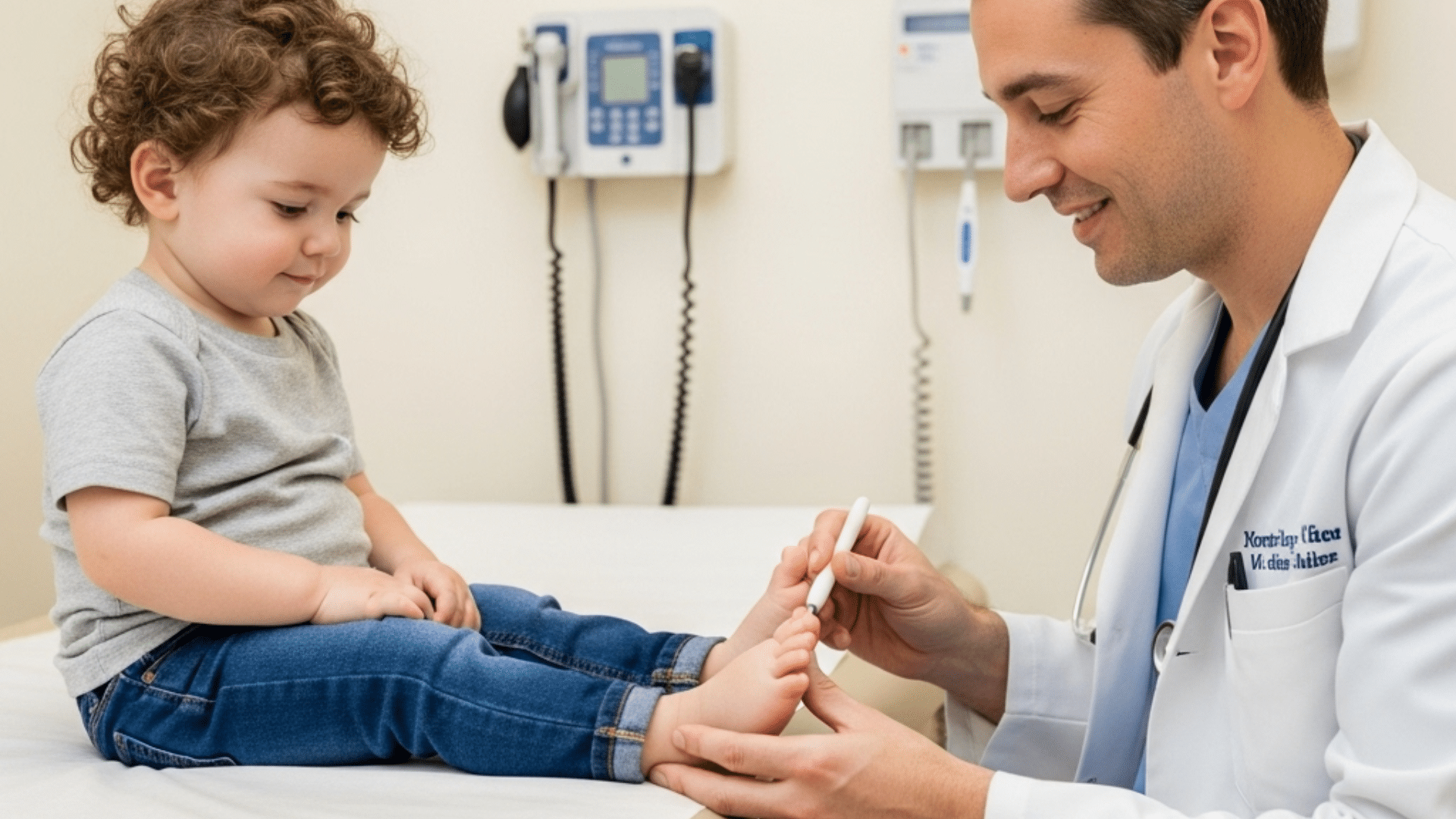Many parents notice their child’s feet turning outward when walking and wonder if this is normal.
Out-toeing affects countless children worldwide, yet most people know little about this common condition.
While some degree of outward foot positioning can be typical during development, certain cases require attention.
Understanding the difference between normal growth patterns and concerning signs helps parents make informed decisions.
This blog explains what out toeing means, examines its main causes, and helps parents understand when professional help becomes necessary for their child’s healthy development.
What is Out-Toeing?

It happens when a person’s feet point outward instead of straight ahead while walking or standing. This creates a “duck-footed” appearance that many parents notice in their children.
Two primary bone issues cause most cases of out toeing:
- Femoral retroversion occurs when the thighbone turns outward at the hip joint.
- External tibial torsion happens when the shinbone twists outward below the knee.
Both conditions affect how the foot points during movement.
It is the opposite of intoeing. While in-toeing causes the feet to point inward toward each other, it causes them to point away from the body’s center line. Some people refer to it as “pigeon-toed” walking.
Understanding Early Signs of Out-toeing in Kids
Parents can spot it by watching how their child walks or runs. The most obvious sign is feet pointing outward instead of straight ahead during movement.
Common signs and symptoms include:
- Waddling gait: Child walks with a side-to-side swaying motion.
- Knees pointing outward: Kneecaps face away from each other while walking.
- Uneven shoe wear: The outer edges of the shoes wear down faster than the inner edges.
- Occasional tripping or falling: Happens when feet get in each other’s way
- Difficulty running: Older children may struggle with speed or coordination.
- Poor balance: Some children struggle with maintaining stability during various activities.
- Hip or knee pain – Older children might experience discomfort in these joints.
Most children with out toeing feel no pain during daily activities. The condition rarely interferes with normal play or movement in younger kids.
However, as children grow older and become more active in sports, some may notice challenges with running speed or balance. Parents should watch for these signs to determine if medical evaluation is needed.
Typical Causes Behind Out-Toeing in Children
Several factors can cause children’s feet to point outward. Most cases stem from how bones develop and position themselves during growth. Understanding these causes helps parents know what to expect as their child develops.
Femoral Retroversion
This happens when the thighbone twists outward at the hip joint. The upper part of the thighbone rotates away from its normal position, causing the entire leg to rotate outward.
Children with this condition often sit in a “W” position because it feels comfortable and supportive. The outward twist affects how the foot points during walking. Most cases improve naturally as children grow and their bones develop properly.
External Tibial Torsion
The shinbone twists outward below the knee in this condition. This twist causes the foot to point away from the body’s centerline during walking. External tibial torsion can affect one leg or both legs.
It often develops from the baby’s position in the womb before birth. Many children outgrow this condition by the age of eight, as their bones straighten during normal growth.
Flat Feet Effects
Children with flat feet often develop out toeing because their foot arches collapse inward. When the arch flattens, the foot naturally splays outward to maintain balance and stability.
This creates an outward-pointing position during walking. Flat feet can be temporary in young children as their arches are still forming.
Fetal Position Impact
Babies spend months in tight spaces inside the womb, which can twist their developing bones. The cramped position may cause the thighbone or shinbone to rotate outward.
Most bone twisting from fetal development corrects itself as children grow and move more freely. Their bones gradually straighten through everyday activities, such as crawling, walking, and playing.
When is Out Toeing Normal?

It is extremely common in toddlers who are just learning to walk. Many children show this foot positioning during their early walking years, and parents should not worry in most cases.
The condition typically resolves on its own between the ages of 2 and 8 years. As children grow, their bones naturally untwist from the positions they held in the womb.
Their walking patterns also mature during this time, leading to straighter foot alignment. This represents normal variation in child development. Every child’s bones and muscles grow at different rates and in slightly different ways.
Most children’s out toeing improves gradually without any treatment. Parents can expect to see steady improvement as their child becomes more coordinated and their bone development continues progressing naturally.
When to see a Doctor?
Doctors use simple physical exams to check for out toeing in children. They watch how the child walks and examine the foot and leg alignment. Muscle strength tests help determine if weakness contributes to the problem.
Most cases don’t need special imaging tests. However, doctors may order X-rays or MRI scans if they suspect serious bone problems or other medical conditions causing the out toeing.
When to seek medical help:
- If it persists beyond the age of 3 to 8 years without improvement.
- The child experiences pain in the feet, legs, or hips.
- Noticeable limping during walking or running.
- One foot turns out much more than the other.
- Frequent tripping or falling due to foot position.
Effective Treatments Options for Out Toeing

Once a doctor confirms that out-toeing requires treatment, several options are available, depending on the child’s age and the severity of the condition. Most children with mild cases require simple approaches, while more serious situations may need specialized care.
Fortunately, many effective treatments can help improve foot alignment and walking patterns. Let’s examine the primary treatment methods doctors use to address the problem in children:
| Treatment Option | What It Involves | When It’s Used | Effectiveness |
|---|---|---|---|
| Observation | Watching how your child walks as they grow | For most kids under 8 with mild out-toeing | Very common approach; most children improve without treatment |
| Supportive Care | Normal play, avoiding early walking pressure, monitor shoes | In young children with mild symptoms | Helps natural growth and prevents problems |
| Physical Therapy | Exercises to strengthen hips, legs, and feet | When there’s weakness or trouble with walking | Can improve walking and muscle balance |
| Orthotics or Special Shoes | Shoe inserts to support feet and improve alignment | Mild cases with flat feet or flexible joints | Not a cure; may help but rarely used alone |
| Bracing | Braces or splints to position feet and legs | Sometimes used in specific cases | Not often effective; used less frequently |
| Surgery | Bone or tendon correction through surgery | Severe cases after growth when pain or problems continue | Rare; only for serious, ongoing issues |
How to Care for a Child with Out Toeing?
Caring for a child with this problem involves simple steps that parents can easily follow at home. Most children need supportive care rather than intensive treatment.
The focus should be on monitoring progress and fostering a healthy environment that supports natural development:
- Encourage active play – Let children run, climb, and play freely to build leg strength and improve coordination naturally through fun activities.
- Monitor shoe wear patterns – Check shoes regularly for uneven wear on outer edges, which can indicate changes in walking patterns over time.
- Record progress with videos – Take short videos of your child walking every few months to track improvements and share with doctors during visits.
- Avoid forcing early walking – Don’t rush toddlers to walk before they’re ready or try to correct their foot position artificially during development.
- Schedule regular checkups – Keep all pediatric appointments to ensure doctors can assess your child’s progress and address any concerns about their walking development.
The Key Takeaway
Out-toeing in children is often a normal part of growing up and usually resolves by itself as kids get older.
Understanding the signs, causes, and when to seek help can ease worries for parents and caregivers.
Most children with out toeing do not need special treatment, but keeping an eye on their walking and talking to a doctor if you notice pain or trouble moving is important.
Have you noticed out toeing in your child or have questions about their walking pattern? Share your experiences or ask your questions in the comments below.
















